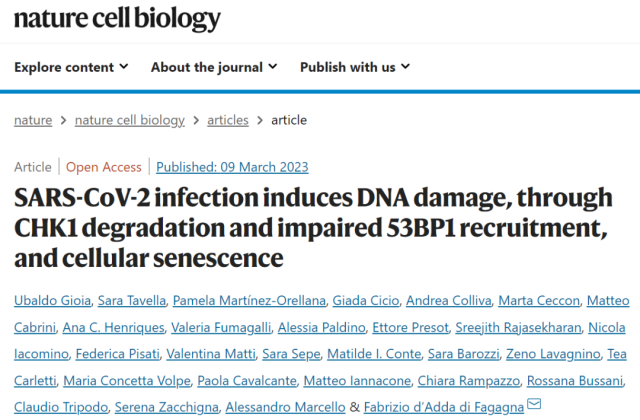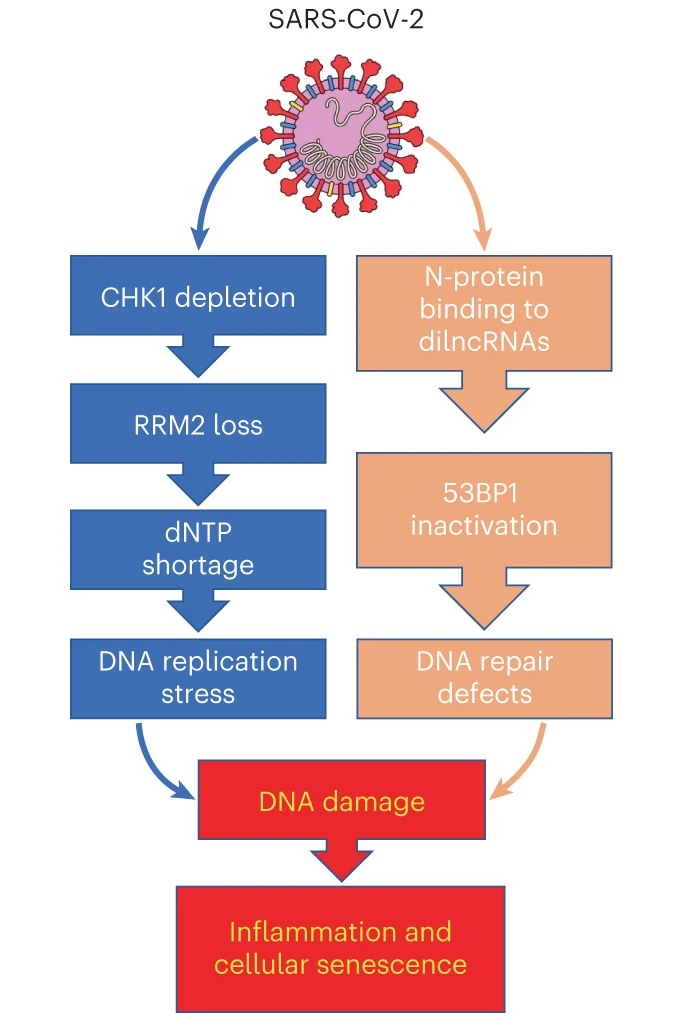COVID-19 has been confirmed to cause DNA damage and cellular aging
- Normal Liver Cells Found to Promote Cancer Metastasis to the Liver
- Nearly 80% Complete Remission: Breakthrough in ADC Anti-Tumor Treatment
- Vaccination Against Common Diseases May Prevent Dementia!
- New Alzheimer’s Disease (AD) Diagnosis and Staging Criteria
- Breakthrough in Alzheimer’s Disease: New Nasal Spray Halts Cognitive Decline by Targeting Toxic Protein
- Can the Tap Water at the Paris Olympics be Drunk Directly?
COVID-19 has been confirmed to cause DNA damage and cellular aging
- Should China be held legally responsible for the US’s $18 trillion COVID losses?
- CT Radiation Exposure Linked to Blood Cancer in Children and Adolescents
- FDA has mandated a top-level black box warning for all marketed CAR-T therapies
- Can people with high blood pressure eat peanuts?
- What is the difference between dopamine and dobutamine?
- How long can the patient live after heart stent surgery?
COVID-19 has been confirmed to cause DNA damage and cellular aging. Will this promote cancer and human aging?
The novel coronavirus (SARS-CoV-2) is an RNA virus that is responsible for the COVID-19 pandemic.
Its 30 kb genome encodes 26 polypeptides/proteins, including 16 nonstructural proteins, 4 structural proteins (such as nucleocapsid proteins) and 6 accessory proteins.
Viral infection affects multiple cellular pathways, including autophagy, ubiquitin-proteasome system (UPS) , and DNA damage response (DDR) .
Although there are many studies on the interaction between DNA viruses and DDR, there is still a lack of specific description and mechanism exploration of the impact of RNA viruses on host genome integrity and DDR.
Many studies since the COVID-19 pandemic have shown that the new coronavirus has a greater impact on human health than other respiratory viruses, and its infection can also lead to long-term COVID-19 (Long COVID) , and it seems to cause accelerated aging in infected people .
Nuclear DNA is the only irreplaceable cell component. Are these serious health consequences caused by the new coronavirus infection caused by the damage to the nuclear DNA?
On March 9, 2023, researchers from Italy’s AIRC Institute of Molecular Oncology published a paper entitled: SARS-CoV-2 infection induces DNA damage, through CHK1 degradation and impaired 53BP1 recruitment, and cellular senescence in Nature Cell Biology.
The study found that infection with the new coronavirus (SARS-CoV-2) caused DNA damage both in cultured cells in vitro and in vivo .
Mechanistically, the proteins ORF6 and NSP13 expressed by the new coronavirus cause the degradation of the DNA damage response kinase CHK1 through the proteasome and autophagy, respectively.
CHK1 loss results in reduced deoxyribonucleoside triphosphates (dNTPs) for DNA synthesis , resulting in impaired DNA replication.
In addition, the new coronavirus nucleocapsid protein (N protein) inhibits the recruitment of 53BP1 protein by binding to damage-induced long non-coding RNA (dilncRNA) , thereby reducing DNA damage repair.
The emergence of DNA damage and the accumulation of impaired repair lead to cellular senescence and inflammation.
That is to say, after the new coronavirus as an RNA virus infects cells, its own RNA replication consumes a large amount of ribonucleoside triphosphate (rNTP) , and this is at the expense of deoxyribonucleoside triphosphate (dNTP ) required for the cell’s own DNA replication. ), in addition, the new coronavirus also hijacks damage-induced long non-coding RNA (dilncRNA) to threaten genome integrity, activate DNA damage response, lead to accumulation of DNA damage, and induce inflammation and cellular senescence.
These findings reveal the profound impact of 2019-nCoV infection on cell biology, which threatens the most important cellular component – nuclear DNA .
Accumulation of DNA damage is known to be associated with cancer and aging .

To determine whether 2019-nCoV infection activates the DNA damage response (DDR) , the research team infected human cell lines with 2019-nCoV and performed immunoblot analysis of DDR markers. It was found that the new coronavirus infection did activate DDR.
Then, the research team used single-cell gel electrophoresis experiments to confirm the presence of DNA fragments in cells infected with the new coronavirus.
These events are accompanied by pro-inflammatory signaling and cellular senescence.
Next, the research team explored the molecular mechanism of the DNA damage response (DDR) caused by the new coronavirus infection .
The research team found that the proteins expressed by the new coronavirus hijack cellular nucleotide metabolism through different mechanisms.
Specifically, the viral factors ORF6 and NSP13 promoted the degradation of checkpoint kinase 1 (CHK1) , an enzyme involved in coordinating the DDR. Decreased levels of CHK1 are thought to lead to the accumulation of ribonucleoside triphosphates (rNTPs) , which is required to facilitate the replication of RNA viruses (COVID-19 is an RNA virus) .
However, the accumulation of rNTPs appears to be at the expense of reduced dNTPs, and intracellular dNTP levels drop significantly after 2019-nCoV infection , which leads to impaired DNA replication and DNA damage .
In addition, the research team also found evidence of the accumulation of DNA breaks in the cells infected by the new coronavirus, because the damaged DNA was not repaired in a timely and efficient manner.
Specifically, the competition between the nucleocapsid protein (N protein) and 53BP1 protein of 2019-nCoV for binding to damage-induced long non-coding RNA impairs the local recruitment of the binding protein 53BP1, thereby reducing DNA repair.
Collectively, these findings suggest that 2019-nCoV infection both induces DNA damage and impairs DNA post-damage repair, ultimately leading to cellular senescence and spreading inflammation.
The study also provides further evidence that these events are occurring both in mouse models of SARS-CoV-2 infection and in humans.

Dual effects of 2019-nCoV infection on host genome integrity and cellular senescence, left: 2019-nCoV infection promotes the degradation of CHK1, leading to a decrease in ribonucleoside diphosphate reductase subunit (RRM2), which further leads to a decrease in dNTP levels required for DNA synthesis, DNA replication is inhibited, resulting in DNA damage; right: the new coronavirus nucleocapsid protein (N protein) binds to damage-induced long non-coding RNA (dilncRNA), resulting in 53BP1 inactivation and DNA repair defects.
These findings reveal the profound impact of 2019-nCoV infection on cell biology, which threatens the most important cellular component – nuclear DNA .
Accumulation of DNA damage is known to be associated with cancer and aging .
Although the long-term impact of COVID-19 infection on the incidence of cancers such as lung cancer is unclear, several studies have shown that it can accelerate aging phenotypes.
These findings may provide a mechanistic explanation for the post-COVID-19 syndrome characterized by accelerated aging, and cellular senescence and inflammatory triggers caused by COVID-19 infection may be an important contributing factor.
In fact, chronic inflammation is thought to be the underlying cause of pulmonary fibrosis, brain degeneration, and general frailty.
Therefore, problems initially confined to the respiratory system after COVID-19 infection may further have systemic consequences.
Fabrizio d’Adda di Fagagna , the corresponding author of the paper , said that this work originated from a meeting in 2019, where he heard a data – two-thirds of the transcriptome in cells infected with the new coronavirus came from the new coronavirus .
Here’s an idea formed in my own head – this must have had a huge impact on the availability of nucleotides that cells need to perform their normal functions.
Although my laboratory does not study virus biology, I happened to study HIV virus during my doctoral period, which also allowed me to regain my enthusiasm for virus research.
Previous studies have demonstrated the correlation of DNA damage and activation of DNA damage response (DDR) with telomere-induced and oncogene-induced cellular senescence, and this study extends DNA damage and activation of DNA damage response (DDR) to Relevance of virus-induced cellular senescence.
Paper link :
https://www.nature.com/articles/s41556-023-01096-x
https://www.nature.com/articles/s41556-023-01097-w
COVID-19 has been confirmed to cause DNA damage and cellular aging
(source:internet, reference only)
Disclaimer of medicaltrend.org
Important Note: The information provided is for informational purposes only and should not be considered as medical advice.



